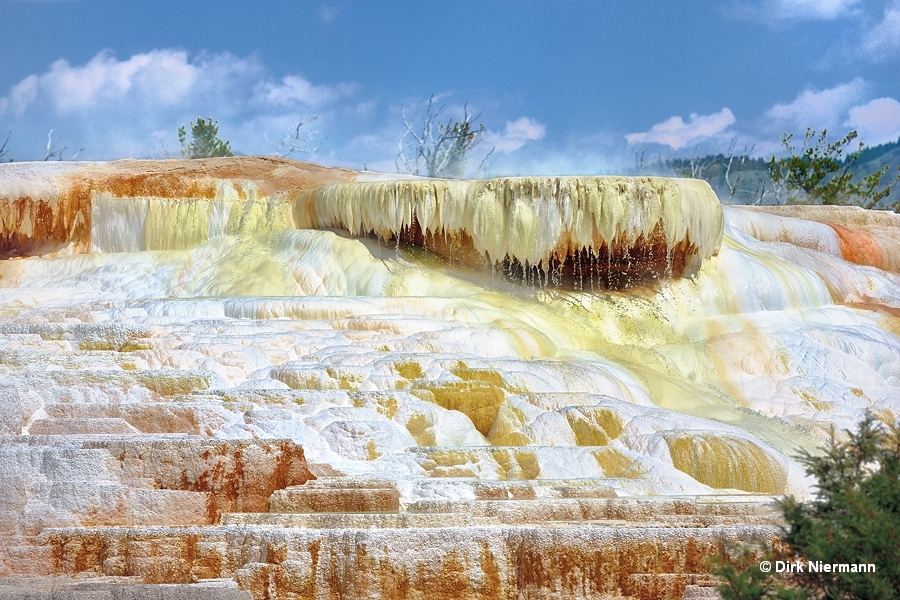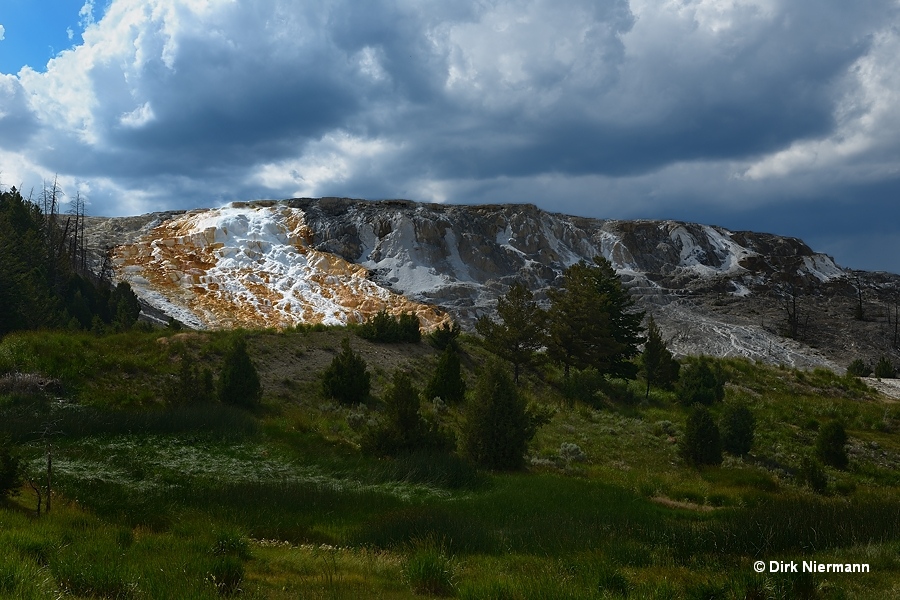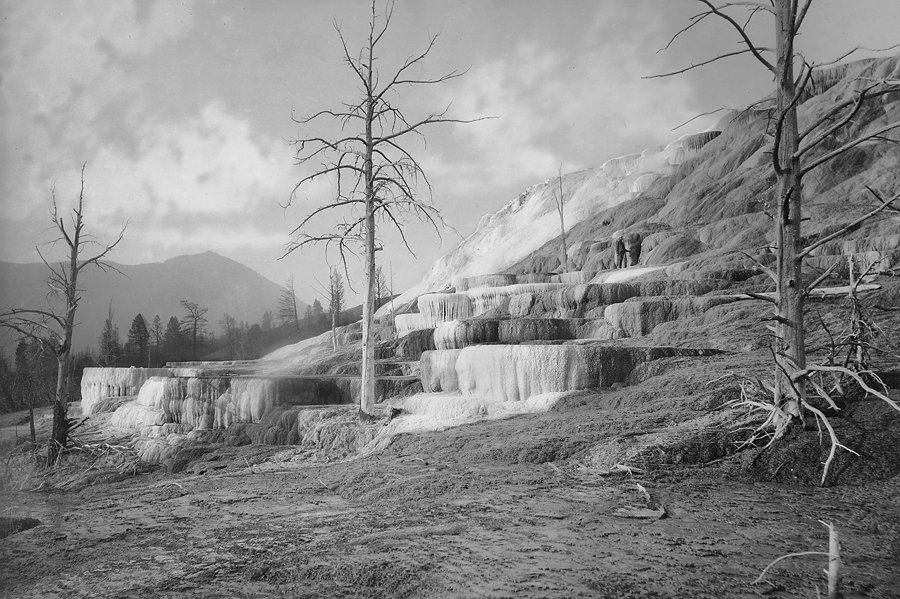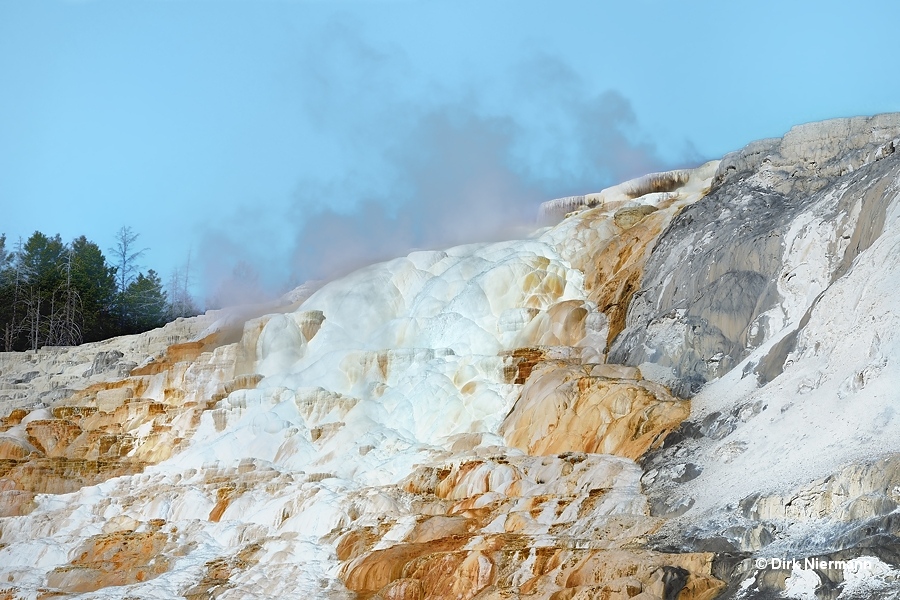Mammoth Hot Springs
Located on the slope of Terrace Mountain near the northern boundary of Yellowstone National Park, Mammoth Hot Springs shows unique characteristics compared to the more southern geyser basins. Not only the lack of geysers due to lower water temperatures of a maximum of 74 °C (165 °F) makes the difference, but in particular also the distinctive travertine deposits of the hot springs. They have reached an overall thickness of roughly 75 m (246 feet) and an expansion of more than 4 square kilometers (1.5 square miles) since the first springs started flowing nearly 8800 years ago.

This travertine is a special form of limestone, consisting of the two minerals aragonite (prevails in vicinity of vents) and calcite, which in chemical terms both are calcium carbonates. Therefore, at Mammoth Hot Springs virtually the same sinter formation processes take place as known from stalactite caves, but above-ground, far more quickly due to the hot water, and by generating a snow-white, highly pure sinter quality. In contrast, the majority of Yellowstone's hot springs precipitate siliceous sinter, and this at very much slower rate. On visits in Mammoth Hot Springs the quite different appearance of travertine terracettes and stalactites from siliceous sinter formations becomes obvious already from afar.
It is assumed that the different mineral content of the thermal water can be attributed to the fact that it comes from Norris Basin and en route along a fault of the Norris Mammoth Corridor it is both enriched with calcium carbonate and heated by partially molten magma.
Down the top of Terrace Mountain a notable number of travertine terraces are extending towards Gardner River. According to Keith E. Bargar (Geology and Thermal History of Mammoth Hot Springs, 1978), the Upper Terraces Area is composed of five terraces, each of which divided into sub-terraces. These are, in a descending sequence from southwest to northeast: the forested and hardly active Pinyon Terrace, the Highland Terrace (including Squirrel Fissure Ridge, Orange Spring Mound, Aphrodite Terrace, Rath Terrace, New Highland Terrace, and White Elephant Back Terrace), the Angel Terrace (including Glen Fissure Ridge), the Narrow Gauge Terrace (including Narrow Gauge Fissure Ridge and Cheops Mound), and the Prospect Terrace (including The Esplanade, Baby Terrace, and Cupid Fissure Ridge).

Subjacent of the Upper Terraces the central plateau with its slopes, called Main Terrace Area, is a patchwork of several terraces, too. The photo above shows the Main Terrace Area from the east, with the overflowing Main Terrace and Marble Terrace on the lefthand side, on a par and seamlessly followed to the righthand side by Pulpit Terrace, Jupiter Terrace and the somewhat lower Mound Terrace. Halfway up the slope at the corner between Marble Terrace and Jupiter Terrace the famous, pulpit-like terracettes of Pulpit Terrace, wherefrom reportedly preacher men proclaimed the Gospel, once were resting on beautifully sculptured stalactite pedestals and displaying high discharge between the 1870s and 1888. Apparently, some of them have then been swallowed by the eastwards growing terrace, while the remainder has eroded almost beyond recognition after the spring ceased flowing in 1926.

In a northward direction the Lower Terraces Area follows. The level underneath Main Terrace is formed by Minerva Terrace and Cleopatra Terrace, a further step leads down to Palette Terrace and Cavern Terrace, whereafter the terrain descends again to the level of Hymen Terrace and Opal Terrace. Almost every terrace comes with its own spring and shares its name with this spring (there may be additional, differently named springs present on a terrace, though). The only exceptions are Pulpit Terrace and Marble Terrace, where I was unable to find correspondingly named springs in books or historical documents. It appears that both names only were applied to terracettes sitting on the eastern slope of the Main Terrace Area. Even though Keith E. Bargar equated Marble Terrace with Jupiter Terrace, Park Historian Lee H. Whittlesey pointed out that "Marble Terrace, located just south of Pulpit Terrace, refers to the east vertical side of the Main Terrace". This means that terracettes on Marble Terrace are fed by Main and Canary springs, while terracettes on Pulpit Terrace apparently were fed by the runoff of Jupiter Springs. Already this example, as just one of many peculiar cases, shows that the naming, which at first glance seems so simple, is to a visitor on location not always easy to comprehend.

Change at Mammoth Hot Springs from year to year, from month to month, and sometimes from week to week may be dramatical. Because of a travertine precipitation rate in very active zones of up to 5 mm (0.25 in) per day, or 1.8 m (6 feet) per year at an overall average around 30 cm (1 foot) per year, springs, pools, terracettes, and terraces may look very different even after a short time span. Therefore, it is sometimes quite challenging to assign a pool or terracettes to a named spring until you do know the location of the vent. And even vents may shift, or run temporarily dry, or emerge for the very first time at an unexpected position. Occasionally, one name stands for more than one vent that feed one source pool or even separate source pools, not to mention the subsequent collecting ponds formed by lower terracettes.
All the place names at Mammoth Hot Springs have been historically established over a time period of nearly 150 years, always depending on the sequence of activity. Taking into account the quick alterations of the limestone structures and vent locations it is not surprising that identifications often turn out to be tricky. Even if this might seem somewhat confusing, on the other hand it means that every visit at Mammoth Hot Springs offers you a unique experience, which is very soon gone forever and cannot be repeated in the same way months or even a few weeks later. Anyway, the ever-changing confectioner's creations of the travertine wonderland enchant visitors time and time again.
Many visitors have the feeling that Mammoth Hot Springs is drying up due to dry springs they remember having seen flowing water years ago, or due to the extended gray, inactive terraces, some of which are already showing signs of decomposition. But this impression is deceiving. Different monitoring projects, done in the 1930s, the 1990s, and in the 2000s, revealed that the water discharge of the Mammoth Hot Springs system, also comprising the Boiling River, has been approximately constant over all the time. Based on this it can be suggested that also in the past hot water never overflowed all terraces or even just the majority of them simultaneously. And in fact, Brett B. Carr et al. have shown that from 1954 to 2010 roughly between 2 % and 10 % of the exposed Lower Terraces travertine deposits were covered by thermal water at any given time, and that this natural variability reflected no downward trend.